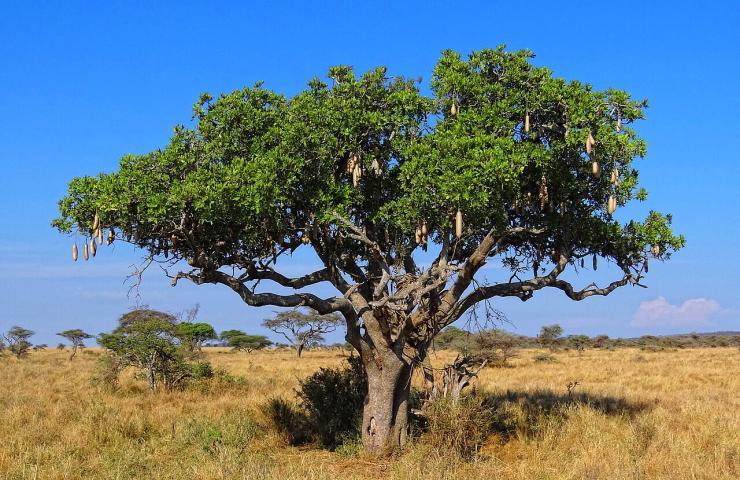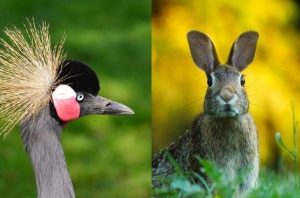Kigelia africana (Lam), Benth (Bignoniaceae family), is a highly valuable medicinal plant that is native to Sub-Saharan Africa. The name ‘Africana’ reflects that the tree is African.
Although there are several species of the genus ‘Kigelia’, Kigelia Africana is the major species that is found across a large part of Africa. The tree is commonly called the ‘Sausage Tree’ because the shape of its fruits looks like a sausage.
The sausage tree is a deciduous tree that can grow up to a height of 20 meters. The bark of the tree is grey and smooth but develops cracks with age. The leaves are elliptic in shape with a length of 10cm when mature. These leaves occur in threes and are compound with a glossy and leathery, wavy appearance, and are crowded at the ends of the branches.
The flowers are red in colour, trumpet-shaped and velvety on the inside. The sausage-like fruit is big with an average of about 60.0cm long and 9.0cm in diameter hanging down the tree on long rope-like peduncles.
Based on the country where it grows, the sausage tree is given different local dialect names. For instance, the sausage tree is called ‘Worsboom‘ and ‘Umfongothi‘ in the Afrikaans and Zulu languages in South Africa, respectively. In Kenya, it is called ‘Mbungati‘, ‘Muratina‘, and ‘Roti‘ in the Swahili, Kikuyu and Pokot languages. In Uganda it’s called, ‘Yago‘ and ‘Edodoi‘ in the Luo and Ateso languages, while in Somalia it is called ‘Bukuraal’.
The sausage tree is mostly a wild tree though it’s sometimes planted in homesteads. Most often the sausage tree can be propagated by seeds, but communities tend to protect saplings that have grown in the wild to enable them to grow to maturity.
In rare cases, the seeds are planted in nursery beds to make seedlings. The seeds are removed as soon as the fruit is harvested for planting because they are viable only for a few weeks after harvest.
For centuries, the sausage tree has been used as a valuable herbal medicine by several traditional healers and African communities. All the parts of the tree (fruits, leaves, bark and roots) are widely used by traditional healers across different African cultures to treat several health conditions.
For example, the fruits are used to manage skin conditions like fungal infections, eczema, psoriasis, boils and leprosy. The sausage tree is widely recognized for its remarkable effectiveness in improving the firmness and elasticity of the skin. In some African cultures, women use the sap from the fruit of the tree to firm the skin around their breasts.
The plant is also claimed to have potent wound-healing activity and for the treatment of skin cancers. The leaves, seeds and fruit pulp are dried, powdered and then applied to treat wounds. Fresh and dried fruits can be boiled with water and given to patients to treat ulcers, sores, syphilis and rheumatism.
Currently, the tree has possible cosmetic and pharmaceutical topical applications, particularly in the formulation of sun-screen skin lotion and creams, breast-firming agents, anti-irritants and soothing agents, anti-reddening skin agents, anti-inflammation agents, anti-aging and anti-oxidant agents on the skin.
Apart from the skin application, the fruit of the sausage tree has also been used as a purgative against dysentery. Several herbalists claim that chewing a small amount of unripe fruit has an aphrodisiac effect in men, but caution has to be taken since this may lead to the development of blisters in the mouth.
The stem bark of the sausage tree has been used by traditional healers to treat health complications like hydrocele (elephantiasis of the scrotum) and rheumatic conditions like inflammation, swelling, and pain in the joints or muscles.
Traditionally, the stem bark is prepared by boiling with water to make a decoction that is prescribed to patients. The stem bark powder can also be put in hot water to make an infusion to treat stomach disorders in children while an infusion from the roots bark is taken to treat pneumonia. The poultice made from leaves is applied topically to treat backache.
Phytochemical analysis from various studies shows that Kigelia africana is rich in medicinal bioactive compounds like alkaloids, tannins, flavanoids, saponins, phenols, terpenoids and glycosides. These compounds offer health benefits to patients suffering from different disease conditions. In fact, the bark of Kigelia africana has anti-inflammatory, analgesic, anti-microbial and anti-cancer properties.
In conclusion, the sausage tree remains one of the most interesting and highly valued medicinal plants in a wide range of communities in Africa, particularly as a potential cosmetic ingredient. (Komakech Richard and Omujal Francis) – (Photo: CC BY-SA 3.0/Bjørn Christian Tørrissen)







